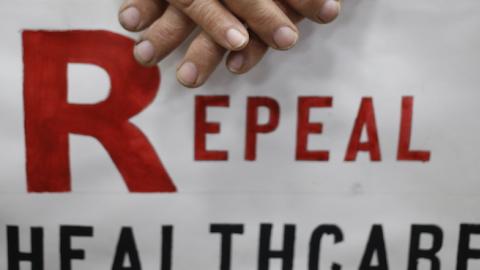There has been a lot of speculation about what will happen to various people if Obamacare is repealed and replaced with a conservative alternative. Would millions lose coverage, as some have claimed, because they couldn't keep their plan and couldn't afford a new plan? Or would people be freed up to buy more affordable insurance than is available under Obamacare? In light of such questions, let's take five representative individuals or families and see what would happen to them:
**Example #1: Maria Richards, a 34-year-old single woman living in Tucson, Arizona and making $42,000 a year**
Maria liked her health plan and doctor, but she lost both when Obamacare was passed and the insurance that she'd freely chosen violated its mandates. Maria is healthy and had a plan that cost $1,424 a year in premiums—exactly the median premium on the eve of Obamacare's implementation (according to the Government Accountability Office) for a healthy 30-year-old woman (Maria's age then) in Arizona. (Maria's plan didn't cover routine care that she could easily pay for out of pocket without a middleman taking a cut—that's where her plan ran afoul of Obamacare—but it provided wide doctor and hospital networks and good coverage in case she ever got seriously ill or injured.)
Maria isn't eligible for an Obamacare subsidy—she's too young and too middle class—and the 2nd-cheapest "silver" plan (Obamacare's benchmark plan) would cost her almost $4,000 a year ($3,980). Maria doesn't want to spend four grand on insurance—and while she'd rather be insured, she knows Obamacare's "community rating" mandate makes it easy to game the system and still be protected if she ever really gets sick. So instead of paying the extravagant premiums under Obamacare, she's paying the individual mandate penalty—$1,050 for her in 2017. In other words, she's paying almost as much under Obamacare for the privilege of being uninsured as she paid for insurance in the pre-Obamacare era.
If Obamacare were repealed and replaced with a conservative alternative, Maria would likely have a 1-time buy-in period (a feature of the House Republicans' “Better Way” plan, during which time she couldn't be charged more, or denied coverage, because of a preexisting condition that she might have acquired while being priced out of the insurance market under Obamacare. If that alternative had tax credits in the amounts proposed by new Health and Human Services Secretary Tom Price, she'd get a tax credit for $1,200.
If this tax credit is really a tax credit (Obamacare's "tax credits" are really direct subsidies to insurance companies), it would come to Maria purely in the form of a tax cut (as she currently pays almost $4,000 in federal income taxes). If she were to use that $1,200 tax cut and supplement it with even half the money she's currently paying for violating the unconstitutional individual mandate, she'd have $1,725 available for insurance ($301 more than she spent pre-Obamacare), plus another $525 left in her pocket.
So, Maria would get a $1,200 tax cut instead of a $1,050 fine, and she'd be insured. For her, repeal and replacement would be a win-win-win—and that's before even factoring in that, without Obamacare's mandates, premiums would drop.
**Example #2: the Millers, a family of four that lives in Chicago, makes $34,000, and has 50-year-old parents and two college-aged kids—one of whom, Denny, has an expensive medical condition**
The Millers are among the minority of Americans who have benefitted from Obamacare. Fully $12,067 worth of the taxpayer-funded subsidies that Obamacare pays to insurance companies funnel the Millers' way. The 2nd-cheapest "silver" plan ($13,242) therefore costs them only $1,175. They greatly value their insurance, as their son Denny needs regular, expensive care.
Under the alternative described in the previous example, the Millers wouldn't need to worry about being denied coverage, or being charged more, because of Denny's condition. Even apart from the 1-time buy-in period, they'd be protected from such denials or upcharges because they've been maintaining insurance all along. Even though they don't pay any income taxes, they would get a refundable tax credit of $7,800 ($3,000 per adult plus $900 per child) to use to buy insurance of their choice—or $7,800 more than they would have gotten before Obamacare was passed. They could use it to buy their Obamacare plan, which would then cost them $5,442 of their own money, or they could shop for value and buy a plan for closer to $9,000, which would cost them almost exactly as much—$1,200—as they pay under Obamacare.
As for out-of-pocket costs (copays, deductibles, etc.), if the alternative were to follow a Price-like model, the Millers would get an additional 1-time, $1,000-per-person tax credit if they chose to open an health savings account. That would give them $4,000 in seed money for covering out-of-pocket costs.
The Millers might not be better off under repeal and replacement (although they might), but they would fare quite well. They'd remain insured, they'd have more choice of plans, and the American taxpayer would be extremely generous in funding their $7,800 in assistance.
**Example #3: Joe and Lisa Jackson, a 40-year-old married couple living in San Francisco and making $65,000**
The Jacksons' neighbors who get health insurance through their jobs get it tax-free, but the Jacksons not only don't get a tax break for buying their own health insurance, they get $0 in Obamacare subsidies. Under Obamacare, they bought the 2nd-cheapest "silver" plan, which costs them $10,652, about a fifth of their after-tax income (but at least they get "free" birth control!)
Under the alternative described above, the Jacksons would get a $4,200 tax credit ($2,100 apiece) to use to buy insurance of their choice. Since they pay more than $5,500 in federal income taxes (and about $12,000 including payroll and state income taxes), this tax credit would be a $4,200 tax cut—giving them about an 8 percent boost in their after-tax income (the rough equivalent of an extra month's pay). In addition, they'd have more choices of plans, and the plans would be more affordable. If they changed plans, as they likely would, they couldn't be charged more—or denied coverage—for a preexisting condition, because they have been buying (overpriced) insurance all along.
**Example #4: Jim and Pam Baker, a 55-year-old married couple living in Wilmington, Delaware and making $22,000 a year**
Under Obamacare, the Bakers are on Medicaid, like most of the "newly insured" under Obamacare. The Bakers don't really consider Medicaid to be "insurance," but it is coverage of some sort. The Bakers are not poor—they're some $6,000 above the poverty line—but they are of modest means. They're frustrated by the long wait times and limited doctor access under Medicaid, and they'd like to be on real insurance.
Under the alternative discussed above, they'd get a $6,000 refundable tax credit ($3,000 apiece) to use to buy insurance of their choice, and they'd get a 1-time, $2,000 tax credit ($1,000 apiece) if they were to open an HSA. In addition, because of the 1-time buy-in period, they couldn't be charged more, or denied coverage, because of a preexisting condition.
On the eve of Obamacare's implementation, the median annual premium for a healthy 55-year-old couple in Delaware was $7,246, per the GAO, meaning half the plans were cheaper than that. With a $6,000 tax credit, the Bakers would be able to buy real insurance.
**Example #5: the Garcias, a family of four that lives in Canton, Ohio, makes $89,000, and has 44-year-old parents**
Before Obamacare, the Garcias had insurance for $5,219—the exact midpoint between the median and cheapest plan for a healthy family of four with 40-year-old parents (their age then) in Ohio, according to the GAO. They liked their plan but lost their plan because of Obamacare. Now their insurance, the 2nd-cheapest "silver" plan, costs $8,147—or 56 percent more than their prior plan, which had a wider doctor network. They get $0 in Obamacare subsidies, and while their neighbors get a tax-break for their job-based insurance, the Garcias wonder why they don't get a tax break for buying their own insurance.
Under an alternative like the one discussed above, the Garcias would get a $6,000 tax credit ($2,100 per adult, $900 per child) to use to buy insurance of their choice. Since they pay slightly more than $6,000 in federal income tax, this tax credit would come entirely in the form of a tax cut. If the Garcias found insurance at their old price—$5,219—they could deposit the $781 in savings from their $6,000 tax credit into an HSA that they would control. They'd be far better off in this scenario than under Obamacare.
These examples suggest what would be true writ large: The vast majority of Americans—especially the middle class and the young—would benefit from having Obamacare be repealed and replaced with a well-conceived conservative alternative. And even the few who have benefitted under Obamacare would do just fine under such an alternative.
Scoring by the nonpartisan Center for Health and Economy found that a similar alternative (released by the 2017 Project, which I ran) would cut federal spending by more than $1 trillion over a decade, reduce premiums substantially, and lead to more people having private insurance than under Obamacare.















